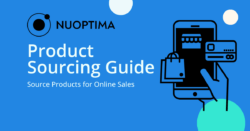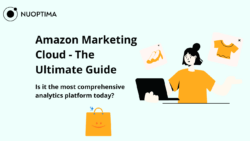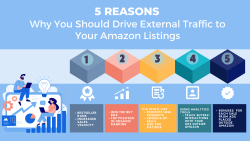Summary
- Amazon’s private-label brands are a growing concern for retailers looking to sell on Amazon, and rightfully so. Amazon has been investing hundreds of millions into growing its private-label brands in the last 10 years to steal market share from third-party sellers.
- Amazon’s aggressive investing, paired with growth within its private label business have caught government and media attention, and Amazon has faced a lot of scrutiny, with brand owners accusing Amazon of using third-party data to launch its own brands.
- Amazon operates over 100 private label brands that sell in almost all major niches, including food and beverage, automotive, clothing and electronics. Amazon is looking to do what brick and mortar stores have been for the last 70 years. Whilst this is great news for customers getting a decent product at a lower price, it’s not so good for small FBA brands that are losing their market share to Amazon.
Introduction
It’s a scenario we’re all familiar with, you find a branded product on an aisle in your favourite retailer, but after looking around you find an identical product at a much lower price point. While this cheaper product tends to look less impressive with its typically basic branding and packaging, for most us, branding is not at the top of our priority list when looking for everyday goods. Its function and price are the most important. With this in mind, most of us would go for the more affordable option.
Retailers have been creating private label products since the mid 19th century, but it’s a new line of business for online retailers like Amazon. This, and Amazon’s purchasing power makes it extremely difficult for small Fulfillment by Amazon (FBA) sellers to compete with Amazon’s private label products.
This article offers insight into how you can compete with Amazon, even if your FBA brand is in a niche that Amazon’s private label brands are operating in.
What Is a Private Label Brand?
Private label is a business model where a manufacturer produces an item sold only by a particular retailer under that retailer’s brand. The retailer uses its branding, including logo, labels, and packaging inserts, not the manufacturers.
The model has been around for decades now—think Aldi in Europe, Walmart in the United States or Tescos in the United Kingdom. Next time you go shopping in Tesco or Walmart, see if you can spot a private label brand. For example, you may see a well-known nappies brand such as Pampers, which will likely be priced much higher than the retailer’s own brand.
The private label model requires some additional effort from the retailer who is typically responsible for developing, producing, marketing and trademarking the private label products.
Like any other retailer, Amazon is using data from its third-party sellers to launch products faster and at a lower price point than its third-party counterparts. Amazon can use its economies of scale to get lower prices from manufacturers and market the products on its platform with the help of world-class expertise from its in-house employees.
How Did Amazon Start Its Private Label Brands?
In 2009 Amazon introduced its first in-house brands—AmazonBasics and Pinzon. Both brands specialised in household essentials. Since 2009, Amazon has ramped up its private label brand portfolio from just 30 brands in 2017 to over 100 to date.
Some of Amazon’s brands, such as the Echo or Kindle, are particularly popular. However, most aren’t known by the general public. While Amazon has listed some of its brands under the “Our Brands” section, the rest are labelled “Amazon brand” in either the title or somewhere in the listing. In more recent years, Amazon has diversified its brand ownership and has also launched over 100 Amazon Exclusive Brands in partnership with established or up-and-coming brands.
These two Amazon brand types have uniquely different business strategies but both fall under the “Our Brands” umbrella.
Amazon doesn’t publicly state which of the brands on their site are private label versus Amazon Exclusive, but it lists the logos of some of the most notable Amazon brands. Here are a few of them:
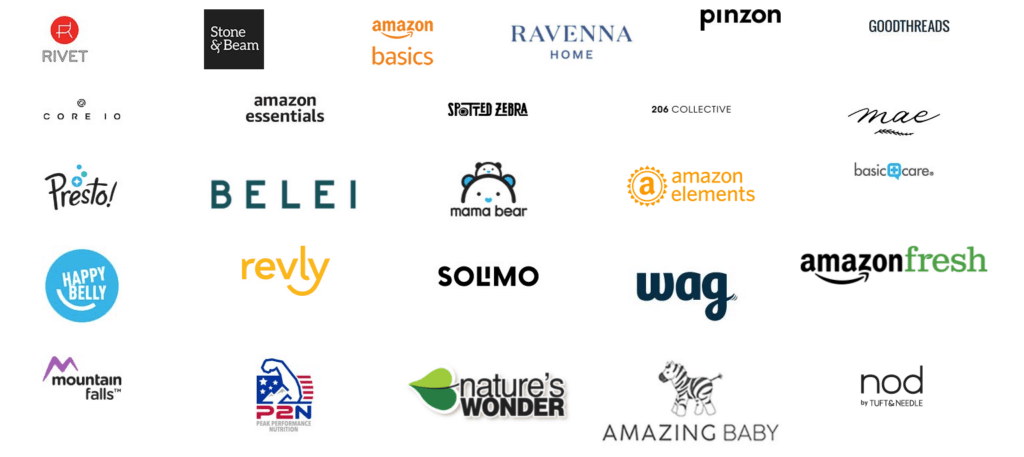
Although Amazon has tried to sell in other niches, such as tech accessories, they seem to be targeting a wider market with everyday goods that meet the average person’s day-to-day demands, a market Amazon is already successful in.
How Many Private Label Brands Does Amazon Have?
Amazon has been very busy building its own suite of brands in the last 10 years. With 158,000 products across 45 brands until 2019, Amazon continues to grow every day, creating more private label brands and becoming a competitor to watch for Amazon sellers. To date, the online giant has launched around 400 private label and exclusive brands.
Amazon’s private label brands started with a focus on three categories; apparel, household goods and groceries. However, the e-commerce behemoth is now expanding to many other categories.
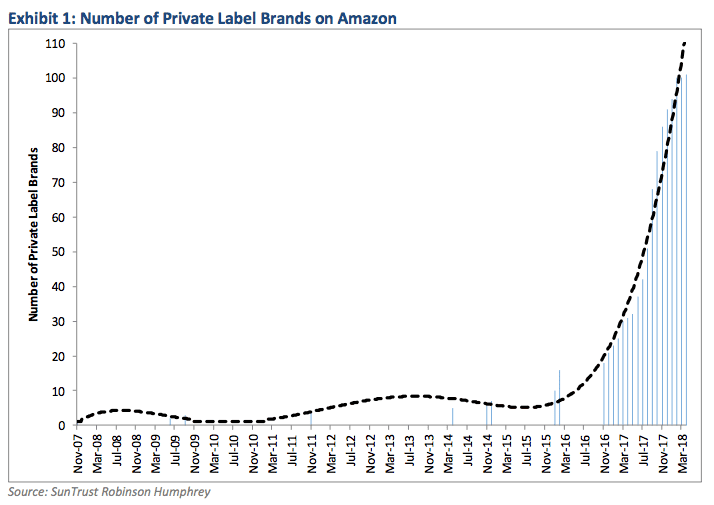
According to GartnerL2 Research Firm, the majority of the 100 private label brands that Amazon owns haven’t performed well and collectively account for less than 1% of sales. The most successful Amazon private label brands are AmazonBasics, Amazon Collection and Amazon Essentials. Amazon seems to favour own-brand items that offer high-quality, generic items for a lower price than anywhere else online.
How Can You Compete With Amazon Private Label Brands?
Selling in a category that Amazon is already dominating will be an uphill battle. Amazon has some obvious advantages, such as better purchasing power, higher marketing budgets and a vast amount of customer data to take advantage of. For smaller e-commerce or FBA brands, competing for market share against Amazon just doesn’t seem feasible.
That said, there are a few things you can do to increase your brand’s chances of success when going head-to-head with the king of e-commerce:
If You’re Not Already Selling On Amazon
If you’re not already selling on Amazon and are looking to launch a brand on the platform, we highly recommend staying away from niches that Amazon has a strong market share in, such as electronics, grocery products, apparel and electronics accessories. Besides the fact that you will struggle to gain an edge over Amazon, these categories aren’t the best niches to launch brands on Amazon anyway due to their naturally competitive nature.
Some of the best niches to potentially start an Amazon FBA brand in are everyday goods such as pots and plant accessories, signs and niche lighting and customisable wallpaper. These areas are super niche and aren’t dominated by Amazon—or any well-known brand for that matter. Basically, the less “cool” the niche is, the better.
If You’re Already Selling On Amazon
Branding and Brand Story
Amazon’s private label brands are only focused on one thing: selling a product at the lowest possible price. However, their brands tend to be lacking in terms of branding or quality. This is where you hold the advantage.
So, you’ve worked hard to get your brand off the ground. You created a quality product. You took the time to build a team and make sure you deliver on value. We know this because we speak to brand owners both on and off Amazon for a living. As a brand owner, you need to make sure your brand story is communicated on Amazon throughout your entire brand journey. This is one of the best ways to stand out against Amazon.
While most e-commerce brands off Amazon do a great job at this, for one reason or another, they fail to communicate their brand story and vision on Amazon, and lose out to Amazon. The top native Amazon FBA brands do an amazing job at telling their brand story, helping them grow despite competing directly with Amazon.
Here are some of the best ways to tell your brand story and to persuade consumers to buy your product on Amazon:
- Use your description to sell the benefits of your product, don’t just list features.
- Upload 6-8 high-quality images, including 2-3 emotionally engaging lifestyle images and at least 1 high-quality social proof-based video.
- Make sure your images are striking, so they pop in search results and ads.
- Make sure you’re taking the customer on a journey from the top of your listing to the bottom with great visuals and engaging sales copy.
- Create a highly visual and benefits-focused store page to drive traffic.
Marketing
Be sure to highlight the features that make your product unique compared to cheaper Amazon private label products. This is where you can use all your market research and customer avatar data to speak to your audience.
Always highlight anything unique about your product offering in your listings and marketing on Amazon. Here are some of the best unique selling points to highlight on your marketing efforts on Amazon:
- Social proof
Mention your social media following if you have amassed a large following.
- Intellectual Property (IP)
Always highlight any patents or trademarks, this makes you stand out from the crowd and increases customer trust and conversion rates.
- Customer results
It’s always useful for potential buyers to see the results your customers have had. The more you have, the better. It’s best to get this in video format and highlight it in your A+ content.
- High-quality materials
Point out any quality differences that may make your product the better choice. For example, if your products are made from real leather whilst Amazon is selling faux leather or a lower quality leather.
- Ethically sourced or ethically made
Customers are always happy to pay more for ethically sourced products.
Customer Service
Exceptional customer service is a competitive advantage for any e-commerce brand selling on any platform, Amazon is no exception. As a small or medium-sized FBA brand, you need to go well beyond your customers’ expectations to ensure a great retention rate, benefit from word-of-mouth (WOM) marketing, and, more importantly, get great reviews.
On a review-based platform such as Amazon, reviews are the lifeblood of your brand and providing great customer service is one of the best ways to ensure an inflow of positive reviews every day. Going above and beyond and providing great customer service is not rocket science, always make sure your customers are satisfied and that they feel like part of a community.
Here are some of our top tips for great customer service on Amazon:
- Answering questions in product listings.
- Ensure that you pre-empt as many customer questions as possible through your listings.
- Sending email follow-ups—thank your customers and request honest feedback.
- Include packaging inserts—simple copy on inserts to express gratitude.
Build a Community
This is by far the most important step you can take to increase customer trust. Whether you are selling on Amazon or not, building a community where you gather your customers to interact with you and your brand ensures a part of your brand’s ecosystem you have control over.
A good example of a great community is a brand called BrüMate. BrüMate has taken over the world of alcohol accessories in the last few years by selling a great product, using brilliant marketing and by building an incredibly loyal and active community primarily through a Facebook group.
Building a strong community of loyal fans will ensure that your brand stands out against Amazon private label brands and well-known brands outside of Amazon too.

Product Variation
Bundling is a simple but powerful way to stand out against the competition on Amazon. You can either bundle a product with your core offering or just add an extra piece to the core offering, something like better gift packaging, a ribbon or a bamboo carrier bag.
Anything that you can add to your hero product makes you stand out against Amazon.
Besides bundling and offering something different in your product, try selling a variation that your competitors are not selling.
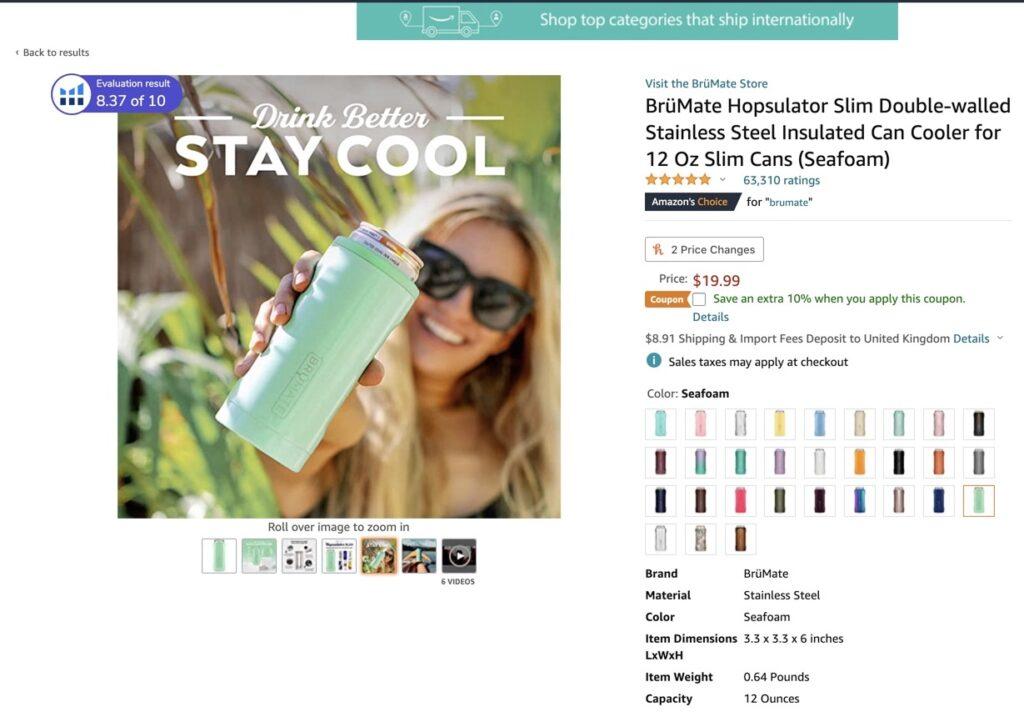
Final Thoughts
Amazon’s private-label brands are here to stay and will likely continue to grow. As a small e-commerce brand, you know that you have to sell on Amazon to get access to hundreds of millions of active buyers on the platform or risk losing market share to your competitors. Whether you’re already selling on Amazon or looking to start an Amazon FBA brand, you have to differentiate your brand from Amazon’s brands by marketing your products’ unique selling points (USPs) through branding, storytelling and building an active community of passionate buyers.
